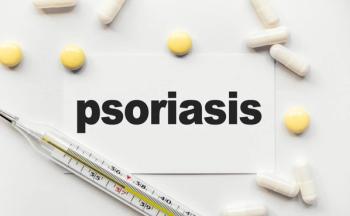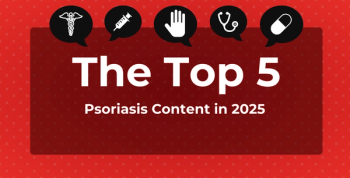
Four-Year Efficacy and Safety Outcomes From reSURFACE 1 and reSURFACE 2 in Patients Given Tildrakizumab for Plaque Psoriasis
Crowley and colleagues presented the 4-year results from reSURFACE 1 at the 28th European Academy of Dermatology and Venereology Congress, held October 9-13, 2019 in Madrid, Spain.
Background
Tildrakizumab (TIL), a high-affinity, humanized, anti—interleukin-23p19 monoclonal antibody, is approved by the FDA for the treatment of moderate-to-severe plaque psoriasis.1 FDA approval was based on results from the phase 3 reSURFACE 1 (NCT01722331) and reSURFACE 2 (NCT01729754) trials.2 Preliminary 4-year efficacy and safety data from the base periods and open-label extensions of these trials are described below.3,4
Methods
reSURFACE 1 and reSURFACE 2 were 3-part, double-blind, randomized, controlled trials that assessed the efficacy and safety of TIL in adult patients with moderate-to-severe chronic plaque psoriasis. In reSURFACE 1, patients were randomized to receive TIL 100 mg, TIL 200 mg, or placebo (2:2:1); in reSURFACE 2, patients were randomized to receive TIL 100 mg, TIL 200 mg, placebo, or etanercept (2:2:1:2).2 In the TIL groups, the monoclonal antibody was administered at weeks 0 and 4 and every 12 weeks thereafter. In reSURFACE 2, patients in the etanercept group received 50 mg twice weekly for the first 12 weeks and once weekly during weeks 12 to 28.2-4 reSURFACE 1 was a 64-week study; reSURFACE 2 lasted 52 weeks.3,4
At base study completion, patients with at least 50% improvement in Psoriasis Area and Severity Index score (PASI) were eligible to enroll in the open-label extension. Efficacy assessments included PASI responses and Physician’s Global Assessment (PGA) responses (0 or 1 with ≥2 grade reduction). The safety analysis examined the incidence rates of prespecified adverse events (AEs).3,4
Results
reSURFACE 1
Among the 638 patients who completed the base study, 525 entered the extension phase, yielding 2210.8 total patient-years (PYs) of follow-up.3 PASI responses in reSURFACE 1 are shown in
A total of 113 (22%) patients in the TIL 100- and 200-mg groups discontinued the study from weeks 64 to 208; the most common reasons were patient withdrawal (8%), AEs (5%), and loss to follow-up (4%).3 During the base study and extension phase, 1410.4 PYs and 1606.5 PYs of exposure were logged for TIL 100 and 200 mg, respectively. Exposure-adjusted rates per 100 PYs were calculated for prespecified AEs, as shown in
reSURFACE 2
Among the 756 patients who completed the base study, 731 entered the extension phase, which yielded 2768.3 PYs of follow-up.4 PASI responses in reSURFACE 2 are shown in
A total of 20.9% of patients discontinued the study by week 200; the most common reasons were patient withdrawal (n = 55; 7.5%), AEs (n = 22; 3.0%), and loss to follow-up (n = 21; 2.9%). During the base study and extension phase, 1513.3 PYs and 1404.7 PYs of exposure were logged for TIL 100 and 200 mg, respectively. Four-year exposure-adjusted rates per 100 PYs were calculated for prespecified AEs, as shown in
Conclusions
TIL 100 and 200 mg produced durable PASI and PGA responses over a 4-year treatment period. Both doses of TIL were associated with a low incidence of AEs of interest.3,4
References
1. Ilumya [prescribing information]. Cranbury, NJ: Sun Pharmaceutical Industries, Inc. 2018. ilumya.com/pdfs/Sun_Pharma_ILUMYA_US_Prescribing_Information.pdf. Accessed October 18, 2019.
2. Reich K, Papp KA, Blauvelt A, et al. Tildrakizumab versus placebo or etanercept for chronic plaque psoriasis (reSURFACE 1 and reSURFACE 2): results from two randomised controlled, phase 3 trials. Lancet. 2017;390(10091):276-288. doi: 10.1016/S0140-6736(17)31279-5.
3. Crowley J, Korman N, Spelman L, et al. Efficacy and safety of long-term tildrakizumab for plaque psoriasis: 4-year results from reSURFACE 1. Poster presented at: 28th European Academy of Dermatology and Venereology Congress; October 9-13, 2019; Madrid, Spain.
4. Langley RG, Gooderham M, Papp KA, et al. Efficacy and safety of long-term tildrakizumab for plaque psoriasis: 4-year results from reSURFACE 2. Poster presented at: 28th European Academy of Dermatology and Venereology Congress; October 9-13, 2019; Madrid, Spain.
Newsletter
Stay ahead of policy, cost, and value—subscribe to AJMC for expert insights at the intersection of clinical care and health economics.





























































